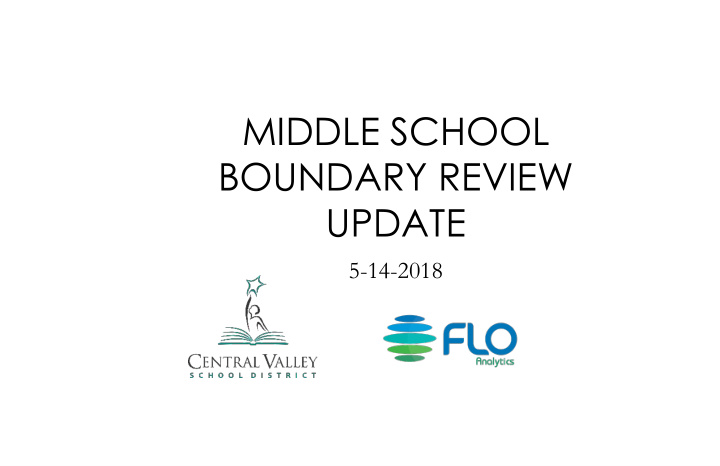



MIDDLE SCHOOL BOUNDARY REVIEW UPDATE 5-14-2018
PROJECT SEQUENCING AND MILESTONES A p r i l M a y - J u n e S u m m e r O c t o b e r S e p t e m b e r 1a. Project Kick Off Task 1: Initial Assessment 1b. Qualitative Assessment Draft Surveys Market Study Interviews Report 1c. Quantitative Assessment Enrollment Assessment Land Use Assessment Projected Enrollment 1d. Develop and Approve Values and Core Principles Task 2: Framework Recommendations 2a. Develop Committee Process 2d. Springboard Proposal Application Committee Process Selected 2b. Develop Citizen Engagement Plan Public Ongoing Process Announcement Updates / Feedback Task 3: Boundary 3a. Boundary Review Committee 3a. Boundary Review Review Process Facilitation Committee Facilitation 3b. Technical Support 3b. Technical Support 3c. Community Engagement Task 4: Final Boundary and Final Transition Recommendations Recommendation
The Process THE PROCESS Initial Assessment Boundary Review Process Final Recommendations
PARENT SURVEYS 455 One-on-One telephone interviews 265 Middle School parents 190 Elementary School parents 100% of respondents confirmed they have children attending CVSD
73.6% AWARENESS 65.3% of elementary school parents 79.6 % of middle school parents
SIX KEY ATTRIBUTES (VALUES) Those ranked highest as most important were: Small class size Attending same school as neighbors
MOST IMPORTANT FACTORS Assuming that their child is safe, parents were asked to identify the next most important factor regarding where their child attended school. The overwhelming response – by nearly four times over the next named factor - is the: Quality of that school and their teachers .
BUSSING • Both elementary and middle school parents agreed that in the event that their child needed to be bussed, a ride of up to 20 minutes would be acceptable. • 57.5% responded that if their child was to be bussed 20 minutes or less it did not matter which school they attended. • For those saying that 30 minutes or less was acceptable a majority still had no strong preference of the school their child attended.
MIGRATION • 78.4% of elementary school parents, and 82.6% of middle school parents in this study have no plans to move from their current home within 3 to 4 years. • Of the 15% that project moving, 77.5% still plan to remain within the District. • Number one area mentioned is Liberty Lake
BOUNDARY REVIEW PROCESS What the most important thing for CVSD to consider when embarking upon and implementing this process. • Proximity to our home/walkability 20.4% • Ability to attend same school as neighbors 13.0% • Class size 12.7%
Summary of Boundary Criteria Based upon the input received from this study, revisions should be considered and implemented using as a foundation: • Proximity to home/walkability • The creation and maintenance of neighborhood schools • Class size/capacity • Future growth • Minimize time spent on bus
Additional Feedback “One of the special things about living in this district is that if people want a voice all they need to do is to participate. The Central Valley School District has been doing a very good job of keeping things well publicized, out in the open, asking residents for their input, and making sure that everyone has a voice.”
When considering boundary revisions the committee will consider, to the extent possible, the following core values: • Maintain a district-wide perspective by considering growth trends and enrollment projections • Develop new boundaries that work to balance school capacities across schools • Consider impact to the smallest number of families • Make efforts to maintain neighborhood schools and the feeder system to the extent possible • Minimize disruptions and impacts to special programs or special populations (e.g., homeless youth, free-and-reduced lunch programs, special education, Title programs) • Maximize to the greatest extent possible, proximity to home/walkability (e.g., not having to cross busy streets and consider natural boundaries) • Consider transportation impacts, and work towards limiting the amount of time required on a bus 4.25.2018
LAND USE AND DEVELOPMENT REVIEW
LAND USE AND DEVELOPMENT REVIEW
LAND USE AND DEVELOPMENT REVIEW
ENROLLMENT AND CAPACITY ASSESSMENT Current District Wide Middle School Facility Capacity District Wide Middle School Projected Enrollment 2021 2026
FACILITY AND TARGET CAPACITY Facility Capacity Committee Maximum Target Capacity
EXISTING BOUNDARIES AND SPRINGBOARD Max Target Capacity COMPARISON Students Residing in Existing Attendance Areas Students Residing in Springboard Attendance Areas
SPRINGBOARD PROPOSAL COMPONENTS Springboard Proposal A starting point of revised boundaries which meet target capacities and consider guiding principles for the committee to begin their revisions from Enrollment and Capacity Assessment Community Guiding Principles and Springboard Surveys Target Capacities Proposal Land Use and Development Review
SUMMARY STATISTICS
SUMMARY STATISTICS
COMMUNITY ENGAGEMENT Community Announcements • Mailers • School Newsletters • Emails • Social Media Webpage content and update schedule • Process description and Q&A • Committee agendas, meeting minutes, documents, and proposals • Feedback mechanism (questions/comments) Open houses • Announcements • Submitting comments • Feedback for the working committee
COMMITTEE SCHEDULE • Kick off meeting – 4/17 • * Board Representatives Update – 4/18 1) Committee Meeting – 4/25: Introduction to the boundary review process committee * Meeting 4/30: Review springboard with District staff * Meeting 5/9: Community survey overview with Critical Data 2) Committee Meeting – 5/9 : Committee workshop * Board Update – 5/14 3) Committee Meeting – 5/23: Committee workshop 4) Open House #1 – 5/30 * Board Meeting Update – 6/11 5) Meeting 5 – 6/13: Committee workshop – Summer Break – 6) Committee Meeting – 9/12: Committee workshop 7) Committee Meeting – 9/19: Committee workshop 8) Open House #2 – 9/26 * Board Meeting Update – 10/8 9) Committee Meeting – 10/10: Committee workshop * Board Meeting Recommendation – 10/22
Recommend
More recommend